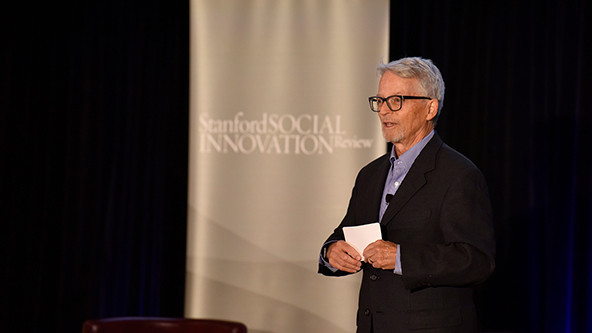 SSIR Editor-in-Chief Eric Nee speaks to the audience at the 2023 Nonprofit Management Institute. (Photo by Charles Russo)
SSIR Editor-in-Chief Eric Nee speaks to the audience at the 2023 Nonprofit Management Institute. (Photo by Charles Russo)
This is the 72nd issue of Stanford Social Innovation Review that I have had the privilege to help edit. And it will also be my last. I am retiring as editor-in-chief of SSIR to start a new chapter that includes travel and spending time with family and friends, as well as writing, advising, and finding other ways to stay engaged in social change.
While I am looking forward to this change, leaving is bittersweet. That’s because being editor-in-chief of SSIR has been my dream job, and the reason I dedicated more than 17 years of my career to helping the publication succeed. The position has enabled me to help advance the global movement for social justice, something I have been involved in since 1968, when as a 14-year-old I joined my first march against the Vietnam War. The articles we have published, the conferences and webinars we have produced, and the global partnerships we have built have all been for the purpose of helping organizations around the world improve people’s lives and change inequitable social systems.
During my tenure, we have brought forth new ideas and approaches to creating more effective social change organizations and to solving difficult social problems. These include seminal articles such as “The Nonprofit Starvation Cycle” (2009), “Design Thinking for Social Innovation” (2010), “Collective Impact” (2011), and “The Curb-Cut Effect” (2017), to name just a few.
When the occasion called for it, we also published articles that raised questions about the effectiveness of the very approaches that we have helped bring to the fore. For example, “Microfinance Misses Its Mark” (2007), “When Can Impact Investing Create Real Impact?” (2013), “When Innovation Goes Wrong” (2016), and “The Problem with Carbon Offsets” (2023).
One of the things I am most proud of is SSIR’s role in helping social innovation become a global field of research and practice. When SSIR began 20 years ago, social innovation was still in its infancy. The term was not widely understood, and few people or organizations were engaged in the work. Today, that has all changed. In my travels around the world, I am always surprised at how many people and organizations use the same lexicon and engage in many of the same approaches.
From the beginning, we’ve been publishing articles from numerous countries about different issues, organizations, and approaches to social change. As a result, people around the world read our articles. More than half of the people who come to our website hail from outside the United States. And we now have six global partners—SSIR Arabia, SSIR Brasil, SSIR China, SSIR en Español, SSIR Japan, and SSIR Korea—who translate our articles into their own languages and also publish original articles.
One of the great things about helping build an organization, rather than working on one’s own, is that when you leave, the organization remains. And that is true of SSIR, where we have an amazing editorial and publishing team dedicated to carrying forward our mission. We are in the final stages of finding a new editor-in-chief, someone who will bring new ideas and talents that will help SSIR continue to evolve, grow, and succeed. Come January, I look forward to joining you as an avid SSIR subscriber.
Support SSIR’s coverage of cross-sector solutions to global challenges.
Help us further the reach of innovative ideas. Donate today.
Read more stories by Eric Nee.

